Back to: Table of Contents | Chapter 2. A Permanent Home
In addition to its problems in seeing its new building through to completion, the 1939-40 season had been a particularly trying one for the Raleigh Little Theatre. With the ending of the WPAs Federal Theatre project, RLT was forced to depend on its own resources for directors.
The 1939-40 season opened with a comedy-mystery, “The Last Warning,” directed by Frances Bailey of the drama faculty of Meredith College and presented November 8, 1939, in the auditorium of Broughton High School with leading roles taken by James Thiem, Sam Weimer, Paul Hoover, Margaret Darst, Helen Saunders and Charles Doak Jr. The News and Observer reviewer, Edith Harbour, was kinder than many critics might have been: “The play was a bit too long, the climax coming about 11:30 with a curtain speech to follow, but the action of the play never dragged for an instant.”
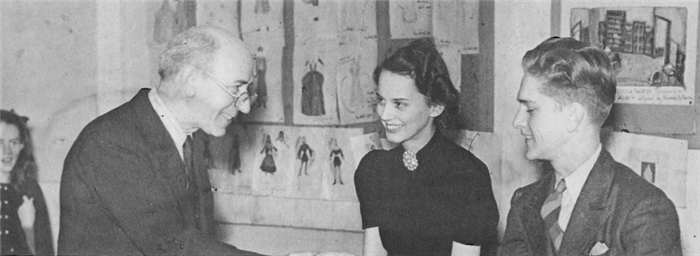
In the cast of “Our Town” (1939) were, left to right, L.M. Dye, Mary Frances Nickell and John Paul Nickell.
The second play of the season, Thornton Wilder’s “Our Town,” which had won the Pulitzer Prize for drama just the year before, was given one of its first North Carolina productions by RLT December 12, 1939, at Broughton High School. Sam Weimer directed, and leading roles were taken by Frances Nickell, John Paul Nickell and L.M. Dye, all newcomers. The N&O reported: “The largest audience ever to witness a Little Theatre play in Raleigh gave a mighty big hand to the leading characters…. It was an unusual play and an unusually large audience and the combination made everybody happy.” So happy, in fact, that Charles Gaddy, superintendent of Raleigh schools, arranged for a repeat performance January 19, 1940, “in order that all high school students might have an opportunity to see the play.”
After a special program of plays for the Wake County chapter of the Meredith Alumnae Association, RLT presented the psychological thriller “Night Must Fall.” The Raleigh Times gave the performers an A for effort but added that “the piece chosen … was too difficult to be anything but slow and as bleak as a March night through two of the three acts.” A major effort went into the production May 4,1940, at Broughton High, of Gounod’s opera “Faust,” a joint presentation with the Raleigh Opera Company. The opera group had received national publicity with a full-page color photo spread in The American magazine, so the opera drew special attention.
In addition, Norman Cordon, the Metropolitan Opera star, a North Carolina native, volunteered his services to sing the role of Mephistopheles. It was believed to be the first time in operatic history that a well-known professional opera star had donated his services to sing along with an amateur cast in a full-length opera. The production was a triumph and The News and Observer reported:
“Deafening applause greeted Norman Cordon, North Carolina-born Metropolitan basso, as he bounded onto the stage last night in the first act of ‘Faust’–a scarlet-clad Mephistopheles in whose grand voice the old Faustus legend came singing alive…. Nor was it Cordon only who stopped the opera. Thomas Edwards, Wilburta Horn, John Farmer Cole, and, finally, the entire cast, all shared in the applause.”
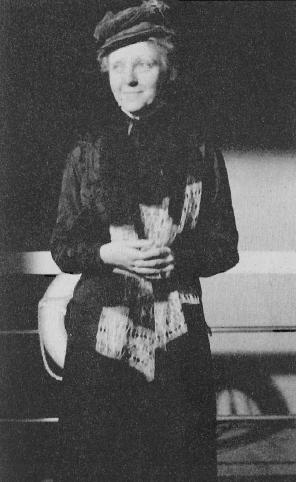
Isabella Cannon in “Outward Bound” (1940)
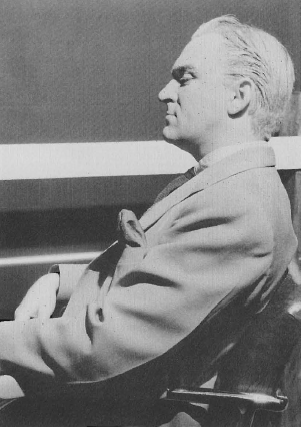
Baker Wynne in “Outward Bound” (1940)
The State magazine was moved to predict-somewhat rashly-that “the small venturing of a North Carolina town into the field of ‘grand opera’ may be the eventual inspiration for just such a needed movement to provide our country with ‘provincial houses’ where young singers may receive training in great opera roles and our people gain more widespread love and enjoyment for the beautiful music of the masters.”
After “Faust” RLT faced that age-old theatrical question: What do you do for an encore? The answer was a production of “Robin Hood” in the newly completed amphitheatre. The performance was scheduled June 28 but postponed because of rain until July 1. Sam Weimer directed, the Raleigh Male Chorus supplied incidental music, and 2,000 people — the largest audience in RLT history at that time — crowded the amphitheatre.
The 1940-41 season was filled with “firsts” for the Little Theatre. The board of directors held its first meeting in the newly completed RLT building September 4, 1940, and the first city-wide membership drive was launched September 11 with a supper at the Carolina Hotel.
Dedication ceremonies for the new building and amphitheatre were held September 12 in the amphitheatre. The state WPA band was bused in from Greensboro, and the Rev. Lee C. Sheppard, pastor of Pullen Memorial Baptist Church, gave the invocation, followed by a speech by C.C. McGinnis, state WPA administrator. Mayor Graham R Andrews accepted the building on behalf of the city. Representing RLT, Arthur Phillips accepted the keys to the building and presented Mrs. Sutton with a scroll of appreciation.
In the principal address of the day, Gov. Clyde R. Hoey said the amphitheatre, theatre building, play area and gardens were “a monument to the ingenuity, above all others, of one dynamic personality, Mrs. Sutton.”
The membership drive September 11-19 signed up 525 members, more than twice the number enrolled the previous year. A sign of those pre-inflationary times: “Seventy-five (of the RLT members) belong to the ‘sustaining’ class by having contributed $10 or more.”
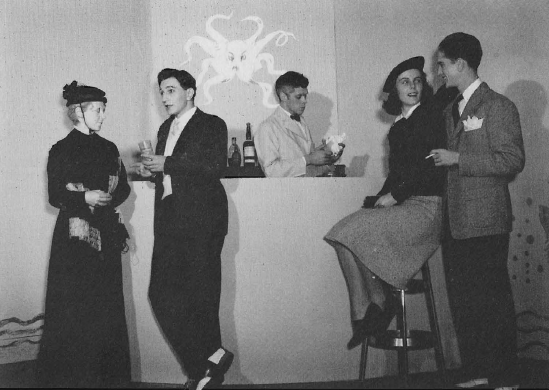
Partial cast of “Outward Bound” (1940), the first production presented in Raleigh Little Theatre’s new building
After the speechmaking and ribbon-cutting were over, the Little Theatre got down to the serious business at hand, choosing as its first production in the new building the play “Outward Bound.” It is not recorded whether the RLT play selection committee was aware of the symbolism, but the play about a group of people setting out on a mysterious voyage — the longest of all — to the hereafter was a complete success. Performances ran October 30 through November 1, 1940. Sam Weimer was the volunteer director and also appeared in the cast, along with Annabelle Bragg, Joe Aquilino, Isabella Cannon (later mayor of Raleigh) and Baker Wynne.
The News and Observer recorded the audience reaction to that historic first night for RLT in its own building:
“Holding the audience spellbound with its intensity of emotion, broken occasionally by bits of humor, ‘Outward Bound’ … opened its three-night run here last night before an almost-capacity audience of approximately 300.”
A workshop presentation of Archibald MacLeish’s “Air Raid” November 7 was part of Raleigh’s observance of National Art Week.
For its second full production of the season, RLT turned from melodrama to the light-hearted comedy of Noel Coward and his trio of one-acters, “Tonight at 8:30.” Sam Weimer again directed and a different cast was used for each of the plays. The Raleigh Times reported: “The capacity crowd of 475 enthusiastically cheered each of the one-act dramas which comprise the bill.”
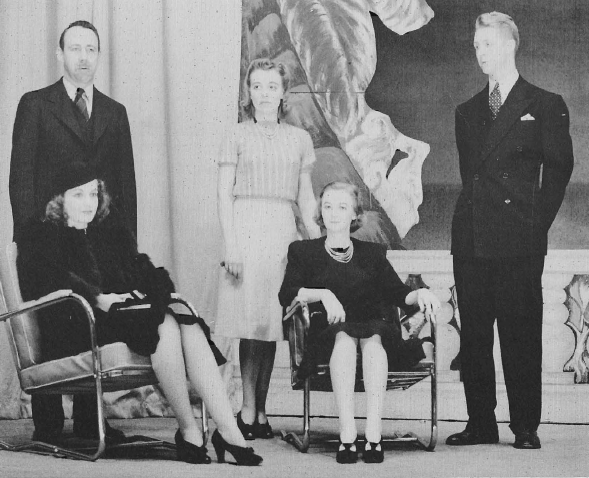
Scene from “Tonight at 8:30” (1940)
On December 16, 1940, the Little Theatre joined with the Lions Club to present a holiday season play, “Christmas Eve Here and There.” The N&O said the production “marked the Little Theatre’s first venture in cooperating with local civic organizations in program work with a view to making the Little Theatre a truly community service group.”
The Little Theatre building those days was busier than the stage of a George Abbott farce. There were workshop classes in make-up, costume design, set building, playwriting, in addition to workshop productions. Two one-act plays written by workshop members, “Nancy Hanks, Bond-Woman” and “Slippers for Cinderella,” were presented in January 1941.
The annual joint presentation with the Raleigh Opera Company was “The Bohemian Girl,” given February 10, 11, 13 and 14. Leading roles were sung by Florence B. Finlator, John Finlator, Ed Hill, Mrs. LV. Sutton, A.J. Fletcher and Tom Cordon, brother of Metropolitan Opera star Norman Cordon.
RLT tried its hand at religious drama March 28, 31, and April 1 with a production of “Family Portrait.” The N&O’s reviewer commented: “That it succeeds so well, creating a living and breathing impression of Christ, although he never appears on stage, is due to a good script, wise direction and able, in some instances inspired, performance.” Edith Burgess drew special praise for her portrayal of Mary, the mother of Jesus.

Florence Finlator in “Bohemian Girl” (1941)
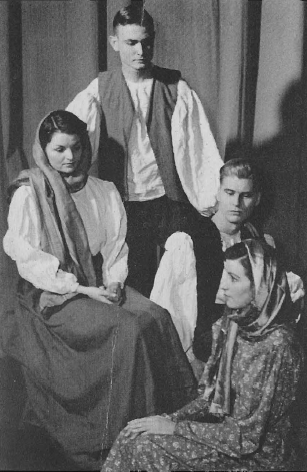
From “Family Portrait” (1941)
RLT closed its 1940-41 season with a production of “The Male Animal” May 22 and 23 with Mrs. Arthur Morris and Robert Ponton in leading roles. The News and Observer reviewer said: “This excellent interpretation of James Thurber and Elliot Nugent’s sparkling comedy on college life rolled wave after wave of laughter off the white plaster walls of the Little Theatre auditorium.”
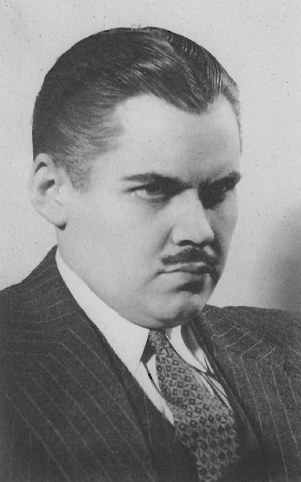
Jimmy Thiem in “The Male Animal” (1941)
During the summer of 1941 — the last carefree vacation time before U.S. involvement in World War II — a production of “Tom Sawyer” was offered free in the amphitheatre. More than 2,000 children, parents and friends attended.
The summer also saw the start of a series of Starlight Concerts in the amphitheatre. A mimeographed list for one of the concerts gives a typical program: the prelude to Act 3 of Wagner’s “Lohengrin,” songs by Paul Robeson, and Tchaikovsky’s Piano Concerto No. 1 in B-flat Minor, played by pianist Egon Petri and the London Philharmonic. Two credits at the bottom of the one-page program will bring waves of nostalgia to Raleigh old-timers: “Sound system by Claude Taylor, 510 West Jones Street” and “Recordings from stock of James E. Thiem, 108 Fayetteville Street.”
The 1941-42 season opened October 15-17 with a production of “Mr. and Mrs. North” with Frances Douglas and Joe Ahern in the title roles. The N&O’s review was one of those mixed-bag affairs that leaves a cast wondering exactly what the critic meant: “An amusing show, with much suspense…. Despite the erratic pace, the lack of coordination and monotonous lighting … individuals of the cast turned in creditable performances in many instances.” A footnote to history: RLT was the first non-professional theatre in the country to present the play.
Two original plays by Ruth D. Jones of Raleigh, “Proceed, Applegate” and “Last Flight,” were presented November 3. The plays were done in a playwriting class conducted by Ann Preston Bridgers.
No one knew it at the time, of course, but those two plays marked the end of business as usual for the Raleigh Little Theatre. George J. Spence, in his thesis on RLT for Florida State University, sums up what happened next:
“The Japanese attack on Pearl Harbor on December 7, 1941, prompted the entrance of the United States into World War II. The Little Theatre, as other organizations throughout the nation, felt the effect and the hardships of the war.
“Without the aid and guidance of a professional director, the Raleigh Little Theatre struggled along as best it could. Money, manpower, and materials were hard to secure.
“With everyone concentrating on the war effort, records were haphazardly kept, productions were fewer and less elaborate, and actors were hard to find. The Raleigh Little Theatre attempted to maintain schedule, however, by special performances free to the servicemen as their contribution to the war effort.”
With a sort of show-must-go-on attitude, members of the Little Theatre opened their second play of the season on December 10, 1941, just three days after Pearl Harbor. It was George Kelly’s “Craig’s Wife,” with William Holt directing and Virginia Tatum and Sam Weimer in leading roles.
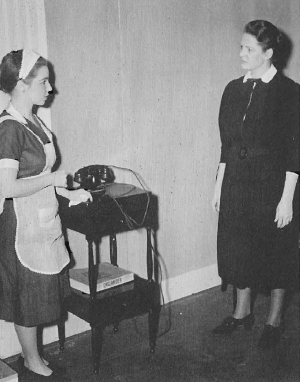
Louise Ahern and Emily Hazell in “Craig’s Wife” (1941).
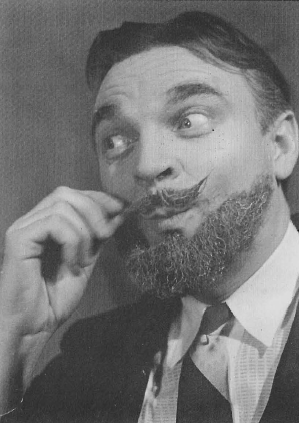
Baker Wynne in “The Man Who Came To Dinner” (1941)
What was then a new comedy, “The Man Who Came to Dinner,” opened in February with the first two performances beginning a new RLT policy of free admission to members of the armed forces. Dr. J.M. Hitch, Little Theatre president, explained: “In this way we hope the local dramatic group is helping to fulfill its obligation to the community as a real civic theatre.”
In an unusual show of hospitality, RLT members put the play’s title into action and literally took servicemen in the audience home to dinner. The News and Observer reported:
“‘The Man Who Came to Dinner’ will have a double interpretation for members of the Raleigh Little Theatre next weekend. One will be the presentation of the phenomenal Kaufman and Hart comedy for special servicemen performances on Saturday night and Sunday afternoon. The other will be the actual taking a man home to dinner by members of the Little Theatre on both Saturday night and Sunday noon.
“Mrs. Louis Sutton, chairman of the special performances for servicemen, announced that this plan of serving as hosts for dinner is being done in cooperation with the regular weekend activities planned for soldiers spending the weekend in Raleigh by the Defense Service Unit of the Wake County Defense Council.”
In April 1942, RLT members got a bonus — an offer of monthly speech classes taught by Margaret Early of the staff of radio station WRAL.
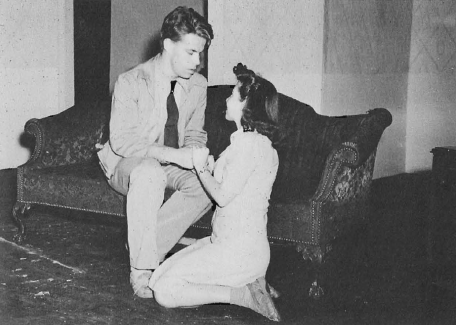
Foster Fitz-Simons with unidentified actress in “Claudia” (1942)
The final bill of the 1941-42 season was the romantic comedy “Claudia,” with Louise Ahern in the title role and the male lead played by Foster Fitz-Simons, playwright, dancer and novelist-and father of RLT’s current director, Haskell Fitz-Simons. In an interview with The Raleigh Times, Foster Fitz-Simons talked of the novel he was writing, his experiences touring with the famed Ted Shawn dancers, and his views on community theatre.
Fitz-Simons said little theatres are in general divided into two categories — “snob efforts” catering to a select few and genuine community projects.
Of the latter, he said: “Such projects are parts of the heritage of an expressive people. We are certainly that, although we had to overcome a lot of timidity to begin with. It has been a long, uphill fight, but we are no longer as self-conscious as we used to be.”
As for RLT’s production of “Claudia,” the critic for The N&O said: “‘Claudia’ is a delightful play … It is the best ‘first night’ that the Little Theatre has had this season…. All eight characters rendered one complete performance of high degree.”
The popular Starlight Concerts of recorded music in the amphitheatre were offered again during the summer of ’42-RLT version-along with a production of “Three Live Ghosts” in June. Scanty records do not indicate whether the play was performed in the amphitheatre or indoors.
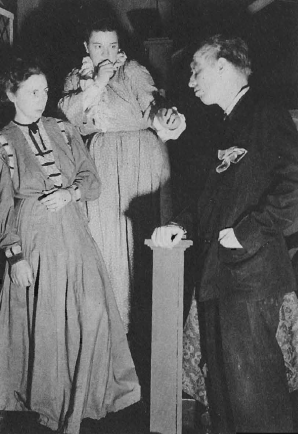
From “Arsenic And Old Lace” (1942)
As a previous history of RLT puts it: “The 1942-43 season remains almost a complete mystery since accurate records or scrapbook articles do not exist during those unstable war years.
“A Raleigh Times article of Aug. 15, 1943, refers to the 1942-43 season, its plays and directors; however, no dates are given.
“The Raleigh Times states that Mrs. Joseph Blickle directed the successful productions of ‘Arsenic and Old Lace’ and ‘My Sister Eileen’ during last season at the local Little Theatre.
“John L. Rembert … directed ‘The Eve of St. Mark’ and ‘The Women’ last year for the Little Theatre, and also appeared in ‘Arsenic and Old Lace.'”
RLT selected “Heidi” for its annual summer production August 13, 1943, in the amphitheatre. John Paul Nickell directed, and The N&O review confirmed that old show biz adage about never appearing on stage with animals or children: “The kids stole the show from their elders.”
The year 1943 also saw creation of the Shakespeare Group, with Mrs. LV. Sutton elected chairman. The Raleigh Times said, “the group will function as a unit apart from the Little Theatre but the Little Theatre will cooperate with the group in the production of Shakespearean plays.” The group’s first production, “Macbeth,” was presented October 2 and 4, 1943, at the Little Theatre with John L. Rembert as director.
For the regular 1943-44 season, RLT decided to meet its problem of having no permanent director head-on. A directorial staff of volunteers was announced for the entire season and included Mrs. Joseph D. Blickle, John L. Rembert and Sam Weimer.
The Times reported that “The present plan is that the three directors will each direct at least one of the public productions and will among themselves agree upon the play selected from the announced list of approved plays and its time of presentation, subject to the approval of the theatre’s board of directors.”
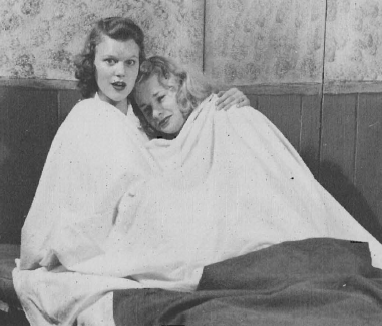
Page Eastman, left, and Barbara Brown in “My Sister Eileen” (1943)

From “My Sister Eileen” (1943)
The season-opener was “Petticoat Fever,” a comedy about an Englishman serving at a remote wireless station in Labrador. The director was Mrs. Blickle and leading roles were taken by C.B. Utley, Arthur S. Link and Janie Silver. The N&O’s reviewer, Jane Hall, later art editor of that newspaper, said: “The Little Theatre again lived up to the high standard of amateur drama it has offered Raleigh during the past few years. The show is a hilarious success from first to last.”
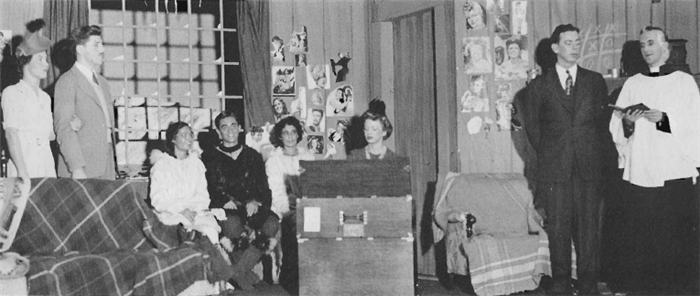
Cast of “Petticoat Fever” (1943)
“Guest in the House,” a dramatic comedy, was the second show of the season, and the cast’s youngest member, 8-year-old Donogh McCutcheon, “stole the show” according to The N&O critic.
RLT joined with the Raleigh Junior League to present the Blickle Marionettes January 13-15, 1944, a step toward development of a children’s theatre.
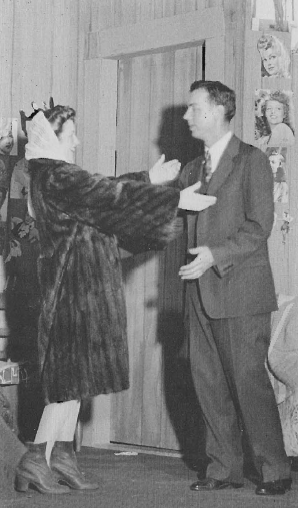
From “Petticoat Fever” (1943)
Meantime, the Shakespeare group had lowered its sights and decided to read plays instead of mounting full-scale productions.
The first regular play of 1944 was Somerset Maugham’s “The Circle,” given March 4-7 with the Sunday, March 5, performance free to servicemen. The N&O account said the play was “performed brilliantly.”
In April 1944, the dream of a permanent children’s theatre in Raleigh was realized with the production of “The Ghost and Mrs. PennY,” sponsored jointly by RLT and the Junior League. The News and Observer reviewer was impressed: “No group, amateur or professional, has presented a performance better timed, paced, or more enthusiastically received.” The cast included Arnold Peterson, Robert St. Lawrence, Webb Surratt, LP Watson, Mary DuBose Watson, David Terry, Atwood Willard, Norma Jean Chambers and Bobby McDonald.
April 12-15, 1944, RLT presented the drama “Tomorrow the World,” a look at what should be done with Nazi youth in the world of tomorrow. Jane Hall’s review in The N&O was a rave:
“Orchids to director Sam Weimer and orchids, too, to the fine cast of Tomorrow the World’ for last night’s superb opening performance of a timely, thought provoking play at the Raleigh Little Theatre. It’s definitely a ‘must’ on your entertainment list.” Miss Hall singled out David Senay for special praise: “His portrayal of Emile as the very brattish brat with a definite shade of Nazi evil genius is so good that you practically want to kill him.”
RLT wound up its 1944 season with a definite change of pace with “Room Service,” the farce about a producer looking for an “angel” to back his show. Mrs. Blickle directed and leading roles were taken by Sam Weimer, Mary Alice Spivey and Bill Hill.
The 10th season of the Raleigh Little Theatre-1945-46-began a new era with the hiring of a full-time professional director, L. Newell Tarrant, who was later to do an “encore” as director from 1977 to 1983.
Tarrant, of Brownwood, Texas, was educated at Baylor and Northwestern universities, trained at the Pasadena Community Playhouse, and during the pre-World War” years was director of community theatres in Temple, Texas; Fort Wayne, Indiana; Tulsa, Oklahoma; and Springfield, Ohio. Tarrant was stationed in New York during his wartime service in the Navy.
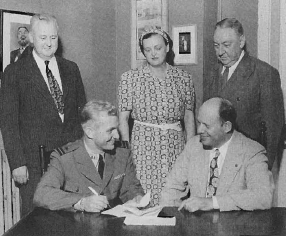
Lt. L. Newell Tarrant signs his contract as RLT’s first fulltime professional director

L. Newell Tarrant. Raleigh Little Theatre Director, 1945-1946 and 1977-1983
Of Tarrant’s appointment, RLT President Horace Seeley said: “As the Little Theatre’s part in Raleigh’s conversion from wartime to peacetime living, we are planning a complete reorganization-including the election of Lieutenant Tarrant as a full-time director-and an expansion of our services and facilities.”
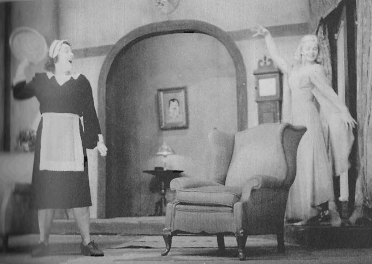
Scene from “Blithe Spirit” (1945-1946).
The season began with a burst of activity as though the Little Theatre were emerging into the sunshine out of the dreary war years. W. Everett Moll of Bethlehem, Pennsylvania, was brought to Raleigh to serve as temporary director until Tarrant’s release from the Navy. Moll directed the first show of the season, “Snafu,” a farce. Participation was definitely up with 135 men and women trying out for the 16 available parts.
Jane Hall, in her review for The News and Observer, called it “a well-paced show with plenty of laughs. Last night’s opening performance showed the pleasing glint of a professional touch, which augurs well for forthcoming plays on the Little Theatre’s 1945-46 schedule.”
The cast was a virtual Who’s Who of future RLT leaders and included Betty Jean Donley, Nancy Stamey (who later headed the drama department at St. Mary’s College), Ann Dearing (known to contemporary RLT audiences as Ann Dearing Lincoln), w.E. Debnam (later known across the state for his writing and radio commentary), Harry Dorsett (who appeared later in numerous RLT shows), and Ira L. Baker (at the time an English teacher at Broughton High).
RLT joined with the Carolina Playmakers in November 1945 to present three performances of Vincent Carroll’s “The White Steed” to raise money for a theater to be built in Chapel Hill honoring the memory of Prof. Frederick Koch, legendary director of the Playmakers and great, good friend of the Raleigh Little Theatre in its earliest years.
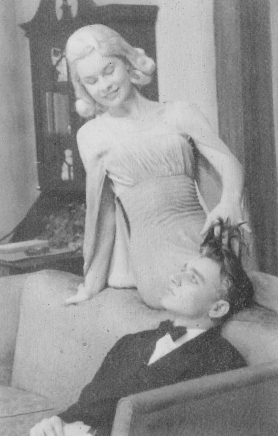
Scene from “Blithe Spirit” (1945-1946).
With the arrival of Newell Tarrant, plans proceeded for RLT’s second show of the season, Noel Coward’s comedy “Blithe Spirit,” presented in December 1945. A co-designer of sets for the show was William Meade Prince, noted painter-illustrator of Chapel Hill. Prince’s wife, Lillian, won praise in The N&O for her portrayal of Madame Arcati, the exuberant medium, “by far the best acting in the play.”
“Blithe Spirit” also was noteworthy for its big technical staff, headed by Armistead Jones Maupin as stage manager and master carpenter. Maupin, now a Raleigh attorney, had just returned from command of a Navy minesweeper in the Pacific during World War II.
As if to prove that the men really were back from the war, RLT chose as its February production “A Bell for Adano,” a drama of wartime Italy that calls for 23 male actors.
March 11-15, 1946, RLT presented “Out of the Frying Pan,” a farce about six stagestruck youngsters. The production was noteworthy for an unusual reason — the identity of The Raleigh Times reviewer, one Jesse Helms, better known as a radio and TV commentator and U.S. senator. In his review, Helms wrote:
“Nine frying-size performers employed more-than-necessary adroitness Monday night in the opening presentation of Francis Swann’s ‘Out of the Frying Pan’ at the Little Theatre, and the general consensus — and a very correct one — was that the popular farce was done up brown.
“…It’s a rather complicated saga of six stagestruck youngsters, three girls and three boys, all of whom do a very moral bit of apartment sharing in New York, which, of course, looks bad to the Bostonian father of one of the girls.
“…Monday night’s presentation was a tribute to the ability of director-manager Newell Tarrant Probably no previous Little Theatre presentation was so well received or got so many curtain calls.”
A new play, “The Rest of Your Life” by Allen McGinnis, was presented by RLT as its fifth play of the season April 23-27, 1946.
The season closed with performance of Thornton Wilder’s “Our Town” May 23 and 25 in the amphitheatre, the second time RLT had presented the play. W.E. Debnam played the key role of the stage manager, with Ann Dearing as Emily Webb and Frank Lamson as George Gibbs.

From “A Bell For Adano” in the 1945-1946 season.
In its review of the plav, The N&O called it “an excellent production,” then commented:
“Unlike the season of 1944-45, the current season has been characterized by good play selection, good acting, and generally excellent productions, all of which has been most gratifying to Raleigh theatre-goers.
“The chief factor in the upswing of the Raleigh Little Theatre’s fortunes has been the addition of a full-time, professionally trained director, L. Newell Tarrant.
“Tarrant has pounded and polished his actors into a smoothly functioning group. That, plus his dramatic ‘know-how,’ has resulted in a series of unusually good performances that provided good entertainment.”
A footnote to the successful season was provided by The News and Observer in a story recording how five RLT cast members had been signed for professional engagements during the summer:
Lillian Prince, who appeared as Madame Arcati in RLT’s production of “Blithe Spirit,” appeared in Chicago with the road company of “Dark of the Moon.”
Glenn Abbott Harden, a member of the cast of RLT’s “Out of the Frying Pan,” signed a contract to playa court lady in “The Lost Colony” at Manteo. She was to be joined in the Manteo cast by Shelton Lewis, who appeared in several RLT productions.

Melvin Pape, Director of Raleigh Little Theatre, 1946-1947
John Adams, who was in RLT’s “Out of the Frying Pan” and “The Rest of Your Life,” was headed for a summer at the Lake Summit Playhouse near Flat Rock, as was Leake Bevil, who appeared in RLT’s “Our Town” and ‘The Rest of Your Life.”
Commenting on the summer exodus to professional theatre, director Newell Tarrant said: “Five persons going from the Little Theatre in one season to professional theatrical engagements is a record of which Raleigh can well be proud.”
It turned out to be a valedictory for Tarrant — at least until his return to the Raleigh Little Theatre in 1977. He resigned during the summer of 1947 to take a theatrical job elsewhere.
Melvin Pape, formerly chairman of the Department of Drama at the University of Texas, was hired to succeed Tarrant as director-manager. Pape had directed shows at the University of Texas, Western Reserve University, and the Austin Little Theatre and had served in the Army Air Corps.
After a summer amphitheatre production of “The Marriage of Figaro” by the Festival Opera Group of North Carolina, sponsored by RLT, the Little Theatre opened its fall season with the political comedy “State of the Union,” by Howard Lindsay and Russell Crouse, designed and directed by Pape. The Raleigh Times reported: “The local theatre group-headed by two talented newcomers, Lorena Gaddy and Howard Maschmeier-has begun the 1946-47 season with a whirl of applause and recognition.”
“State of the Union” also marked the first time that the Little Theatre hung out the “Standing Room Only” sign. Because of the overflow crowds, an extra performance was given October 29.
RLT presented Smetana’s opera “The Bartered Bride” November 19 and 20, 1946, at the auditorium of Hugh Morson High School. The high school auditorium was used because of the size of the production-75 people, including singers, dancers and 15-piece orchestra. The N&O said that “top honors, both musically and theatrically, go to A.J. Fletcher, bass; Clifford Bair, tenor; and Jeanette Scrable, lyric soprano.” The production was directed by Bair and Pape.
The Little Theatre moved back home to Pogue Street for its presentation of “I Remember Mama,” opening December 9, 1946, with a cast of 22 humans and one cat.
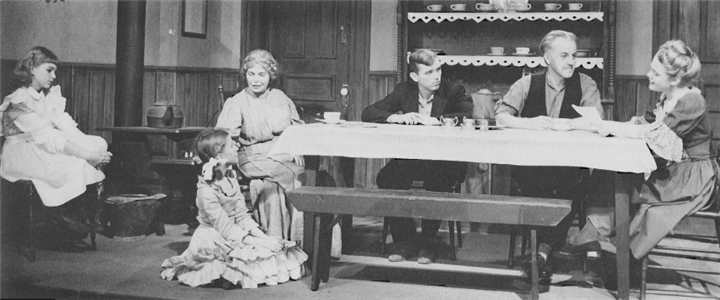
“I Remember Mama” (1946) featured, left to right, Peggy Holt. Jean Lamoureau, Anne Granger, Jim Skeeter, Paul Peach and Anne Arendell. Click for a larger version
The drama “Angel Street,” presented in February 1947, was hailed by The Raleigh Times as “a triumph of fine acting, good timing, and excellent staging.” Baker Wynne and Ada Morris played the leading roles. (Wynne, who taught at what was then State College, sported a Van Dyke beard and acquired the title “the poor man’s Charles Boyer” for his performance in the play.)
A brief item in The N&O before “Angel Street” opened gives a glimpse of the backstage crises that have always been part of the theatre. Headlined “Wanted: A Derby,” the item says: “‘Angel Street; now in rehearsal at the Raleigh Little Theatre, is laid in the late 1800s and props of that vintage are sorely lacking by the local group.
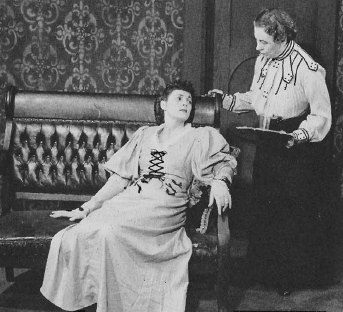
“Angel Street” was presented for the first time in the 1946-1947 season
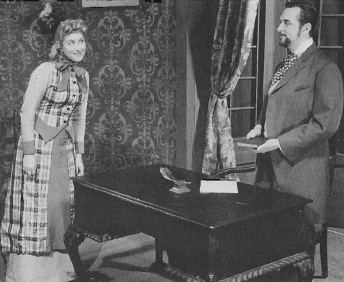
Baker Wynne in a scene from “Angel Street” (1946-1947) with an unidentified actress
“Mrs. Jane B. Holt, property chairman, and Mrs. Josephus Daniels Jr., costume chairman, announced yesterday that they will welcome the loan or the gift to the property room of Victorian sofas, chairs, tables and clothes. “One of the most urgent needs is a brown derby, and other musts include men’s striped trousers and cutaway coats.
“The theatre is willing to renovate both period furnishings and costumes and will return the articles — if the owners insist upon it.”
Presumably, the appeal worked. At least “Angel Street” went on as scheduled.
RLT chose Maxwell Anderson’s “Joan of Lorraine” and the consensus seems to have been that the theatre’s reach, at least in this instance, definitely exceeded its grasp. The N&O said: “Fine acting on the part of three members of the cast (Lorena Gaddy, Melvin Pape and Jenny Moore) last night saved a too-ambitious production of Joan of Lorraine for the Raleigh Little Theatre. … (The ensemble) gave its opening performance to a small, restless audience.”
RLT ended its 1946-47 season with a surefire crowd-pleaser, Moss Hart and George Kaufman’s “You Can’t Take It With You.” It was scheduled to run May 12-17, but an extra performance was needed because of overflow crowds. Jo Spivey of The N&O commented: “Melvin Pape is to be congratulated for a splendid job of director. ‘You Can’t Take It With You’ is well worth two hours of anybody’s seeing time.”
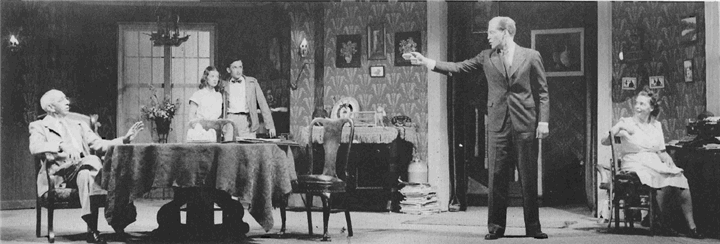
The cast of “You Can’t Take It With You” (1947): left to right, A.J. Fletcher, Frances Wallace, Ed Rankin, William E. Roberts and Anne Granger. Click for a larger version.
Then, as a summer bonus, “The Great Magician” was set for June 26-28, 1947, in the amphitheatre. The production, a modern version of medieval Italian commedia dell’arte, was rained out opening night, resulting in the following story, which appeared in The News and Observer and was later picked up by The New Yorker magazine:
“Show Tonight
The opening performance of the Raleigh Little Theatres new comedy, ‘The Great Magician,’ will be held tonight at 8:15 in the amphitheatre — if it doesn’t rain.
… During the intermission the audience will witness a swimming match in the amphitheatre’s orchestra pit.”
Commented The New Yorker: “Playing both ends against the middle, aren’t you, Pape?”
It’s unlikely that the deluge had anything to do with it, but director Pape resigned during the summer and the RLT Board of Directors named Ainslie Pryor of Memphis, Tennessee, to succeed him. The Raleigh Times reported:
“Pryor, unanimously chosen by the board of directors from over 40 candidates for the position, comes to Raleigh from Cleveland, Ohio, where he was director at the Cain Park Theatre and associated with L. Newell Tarrant, a former director-manager of the Raleigh Little Theatre.”
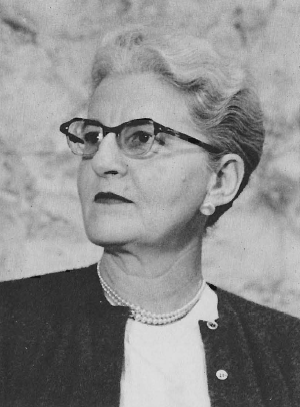
Rebecca S. Gill, Raleigh Little Theatre’s Office Secretary, 1948-1964
Pryor had studied drama at Southwestern University, acted with the Memphis Little Theatre, and been assistant director of the Stable Playhouse there. During World War II, he served in the merchant marine. After the war he had done radio work.
RLT also announced the appointment of William I. Long as technical director for the 1947-48 season. Long had A.B. and MA degrees from the University of North Carolina and had taught dramatics at Marion College in Virginia and McGill University in Montreal. He also had worked as master of properties for ‘The Lost Colony.”
The board also announced that Mrs. Allen Gill had accepted the position of executive secretary to RLT for the 1947-48 season. Rebecca Gill had graduated from Woman’s College in Greensboro and for three years had been a scholarship student at New York Opera Comique. The theatre was forced to close during the depression, ending Mrs. Gill’s formal training in the theatre. She also had worked as personnel director of the Planned Parenthood Federation in New York. During the war she moved to North Carolina to be near her husband and was a chief hostess and service club director at Army bases in the state. Upon her husband’s discharge from service, they returned to Raleigh.
Mrs. Gill was to remain on the theatre staff until 1965. Her appointment symbolized a new feeling of permanence in the theatre’s operation. If the 1930s had been years of bold pioneering and the ’40s a time of testing endurance, the approaching 1950s loomed as a time for solid growth for a Raleigh Little Theatre that had sunk its roots deep in the community.
